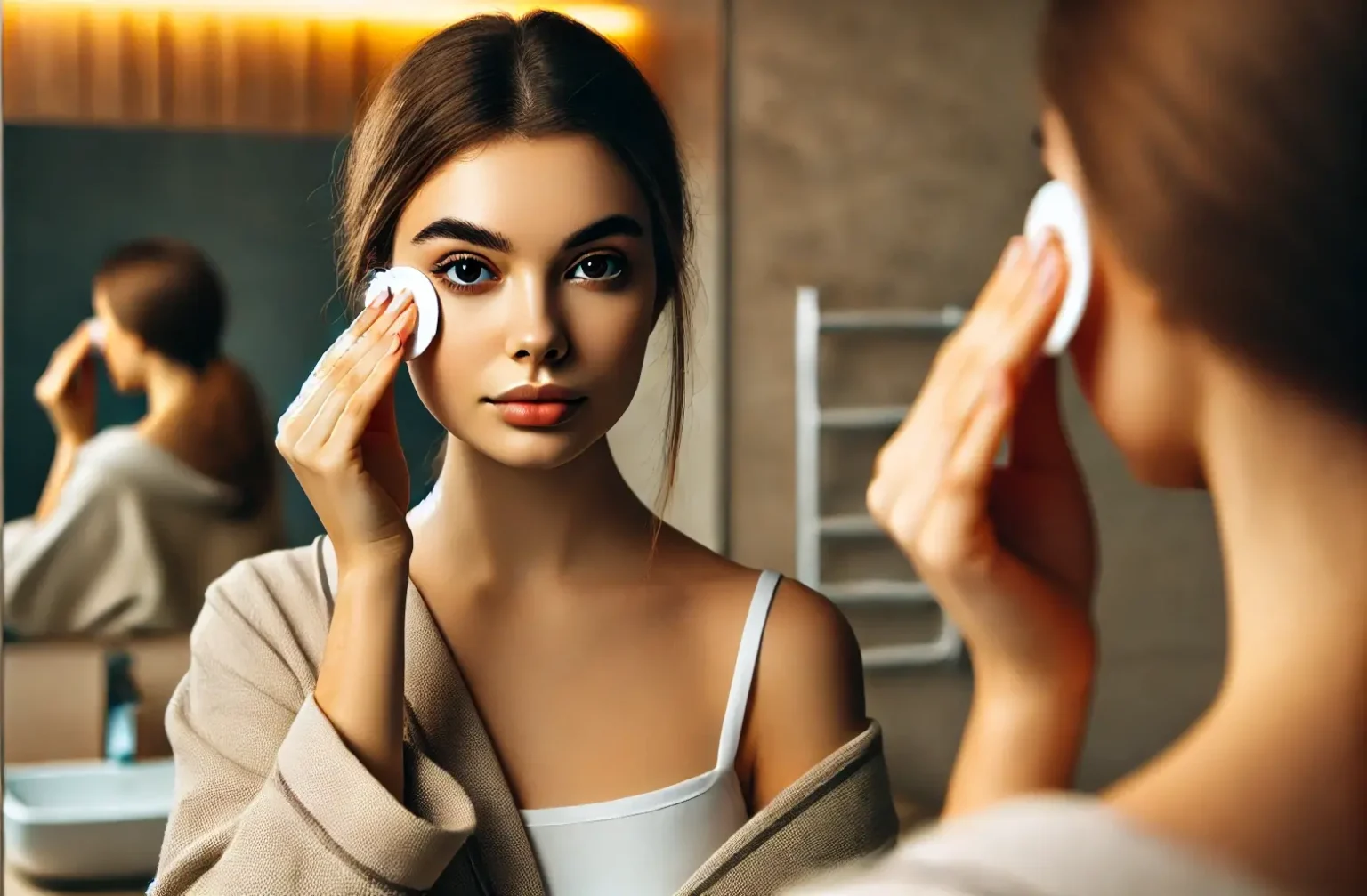Achieving radiant, healthy skin isn’t always about using the fanciest products or following the latest skincare trends. In fact, one of the biggest secrets to great skin is avoiding the common mistakes that sneak into our routines. We’re constantly bombarded with advice on what to do for our skin—whether it’s layering serums or trying the latest “miracle” cream. But here’s the truth: sometimes, knowing what not to do is just as important.
Think about it—how many times have you heard that more is better? More exfoliation, more product layering, more scrubbing! While well-intentioned, these habits can actually do more harm than good, leading to breakouts, sensitivity, and even premature aging. We’ve all been there, applying product after product, only to wonder why our skin isn’t thriving the way we hoped.
In this guide, we’ll walk through some of the most common skincare mistakes you might be making without even realizing it. From skipping sunscreen on cloudy days to over-exfoliating or neglecting your neck, these slip-ups can hold your skin back from reaching its full glow potential. Let’s break down these missteps, debunk some persistent skincare myths, and set you up with practical tips that make a real difference.
Ready to level up your skincare game? Here are ten skincare mistakes to avoid if you want to give your skin the love it truly deserves. By the end, you’ll feel confident knowing exactly what to change in your routine for that healthy, happy skin you’ve been dreaming of.
Table of contents
- 10 Skincare Mistakes to Avoid
- Skincare Mistake #1: Skipping Sunscreen on Cloudy Days
- Skincare Mistake #2: Over-Exfoliating Your Skin
- Skincare Mistake #3: Not Removing Makeup Before Bed
- Skincare Mistake #4: Over-Cleansing Your Skin
- Skincare Mistake #5: Ignoring the Neck and Décolleté
- Skincare Mistake #6: Not Moisturizing Oily Skin
- Skincare Mistake #7: Layering Products Incorrectly
- Skincare Mistake #8: Switching Products Too Often
- Skincare Mistake #9: Using Dirty Makeup Brushes and Towels
- Skincare Mistake # 10: Ignoring Seasonal Skincare Changes
- Conclusion
10 Skincare Mistakes to Avoid
Skincare Mistake #1: Skipping Sunscreen on Cloudy Days
Why Sunscreen Is a Year-Round Essential
It’s easy to think sunscreen is only necessary when the sun is shining. But the truth is, one of the most common skincare mistakes is skipping sunscreen on cloudy days. UV rays don’t take a break just because it’s overcast. Harmful ultraviolet (UV) rays penetrate clouds and even windows, reaching your skin and accelerating signs of aging, like fine lines, wrinkles, and sunspots. According to the Skin Cancer Foundation, about 80% of the sun’s UV rays make it through clouds, meaning your skin is still exposed to these damaging rays, even when it looks overcast.
The Impact of Skipping Sunscreen
Beyond just cosmetic concerns, skipping sunscreen regularly puts you at risk for more serious conditions like skin cancer. Studies have shown that consistent daily use of sunscreen can cut the risk of developing melanoma, the deadliest form of skin cancer, in half. Sun damage is cumulative, so each day without protection contributes to long-term skin changes.
What You Should Do
Make sunscreen application a daily habit, no matter the weather. Use a broad-spectrum sunscreen with at least SPF 30 to protect against both UVA (aging) and UVB (burning) rays. Broad-spectrum formulas shield your skin comprehensively, and SPF 30 is generally recommended as the minimum for effective protection. Don’t forget to reapply every two hours if you’re outside or exposed to sunlight through windows, and even more frequently if you’re sweating or swimming.
Pro Tip: Keep a small bottle of sunscreen in your bag or at your desk as a reminder. If you’re looking for something that layers well under makeup, there are plenty of lightweight, matte options that won’t leave a white cast or greasy feel.
For a deeper dive on SPF products, check out our guide to How to Choose the Right Sunscreen for Your Skin Type? .

Skincare Mistake #2: Over-Exfoliating Your Skin
Why Too Much Exfoliation Can Harm Your Skin
Exfoliation is a great way to remove dead skin cells and reveal a brighter, smoother complexion. It can leave your skin feeling refreshed, boost product absorption, and even help reduce clogged pores. However, like many skincare mistakes, too much of a good thing can quickly become a bad thing. Over-exfoliating—whether with physical scrubs or chemical exfoliants—can disrupt your skin’s protective barrier, leading to increased sensitivity, redness, and dryness. By weakening this barrier, your skin becomes more vulnerable to environmental stressors like pollution, UV rays, and bacteria, increasing the risk of irritation, breakouts, and long-term damage.
Recognizing Signs of Over-Exfoliation
If you’re noticing persistent redness, stinging, dryness, or an unusual sensitivity to skincare products, it’s likely a sign you’re overdoing it with exfoliation. Other symptoms include a rough texture, more visible pores, or skin that feels tight after cleansing—these all signal that your skin barrier might be compromised and in need of some Tender Loving Care (TLC).
Best Practices for Exfoliation
To get the benefits of exfoliation without the downsides, keep it simple. For most skin types, exfoliating once or twice a week is plenty. Those with sensitive or dry skin may only need it once a week, while oily or acne-prone skin types might handle it twice. Avoid harsh physical scrubs with large or jagged particles that can create tiny micro-tears in your skin; instead, opt for a gentle chemical exfoliant with alpha hydroxy acids (AHAs) like lactic acid or beta hydroxy acids (BHAs) like salicylic acid. These ingredients work by dissolving dead skin cells without the abrasive action, offering a smoother and more controlled exfoliation experience.
Pro Tip: If you’re new to exfoliation, start slow. Apply your exfoliant every 7–10 days at first and gradually increase as your skin adjusts. Always follow up with a hydrating serum or moisturizer to replenish and protect the skin barrier.
Skincare Mistake #3: Not Removing Makeup Before Bed
The Consequences of Sleeping in Makeup
After a long day, it’s tempting to skip the hassle of removing makeup and head straight to bed. However, this simple act of omission is one of the most common skincare mistakes that can do serious harm to your skin. Sleeping in makeup traps dirt, oil, and environmental pollutants against your skin, clogging pores and setting the stage for breakouts and irritation. Even worse, leaving makeup on overnight disrupts your skin’s natural renewal process, increasing the risk of premature aging, dullness, and congestion. According to the American Academy of Dermatology, this skincare mistake can speed up skin aging and increase acne risk, as your skin misses out on the chance to breathe and repair itself.
The Importance of Double Cleansing
To effectively remove makeup, sunscreen, and impurities, consider using the double-cleansing method. This involves starting with an oil-based cleanser, which breaks down oil-based products like foundation, mascara, and waterproof makeup without stripping your skin. Follow up with a gentle water-based cleanser to remove any remaining residue, leaving your skin fresh, clean, and ready for the rest of your skincare routine. Double cleansing is especially beneficial if you live in an urban environment or wear makeup daily, as it ensures every trace of dirt and pollution is thoroughly removed.
Pro Tip: Invest in a silk pillowcase if you’re prone to breakouts. Silk creates less friction than traditional pillowcases, which can reduce skin irritation and prevent bacteria buildup that contributes to acne. Plus, silk pillowcases are gentler on the skin and hair, making them a win-win!
Skincare Mistake #4: Over-Cleansing Your Skin
Why Cleanliness Isn’t Always the Best Policy
It’s natural to think that washing your face more often will keep it healthier and clearer, but too much of a good thing can backfire. Skincare mistakes like over-cleansing strip your skin of its natural oils, which are essential for maintaining a balanced, hydrated barrier. When you remove these oils excessively, your skin can become dry, irritated, and more susceptible to environmental damage. What’s more, when the skin’s moisture balance is disrupted, it may react by producing more oil to compensate, potentially leading to acne flare-ups and clogged pores—exactly what we’re trying to avoid!
How Often Should You Cleanse?
For most skin types, dermatologists recommend cleansing twice a day: once in the morning to remove any sweat or oil that accumulated overnight, and once at night to wash away dirt, makeup, and pollutants from the day. However, if you have very dry or sensitive skin, you might benefit from a gentler approach—try using a hydrating cleanser in the morning to avoid over-drying, and a more thorough cleanser at night if you need it.
Choosing the Right Cleanser
The key to avoiding over-cleansing lies in choosing the right type of cleanser for your skin. Avoid cleansers with harsh sulfates, which are surfactants that can strip your skin’s natural oils. Instead, opt for sulfate-free formulas that clean effectively without disrupting your skin’s moisture barrier. Look for gentle ingredients like glycerin, ceramides, or aloe vera, which help retain moisture and leave your skin feeling balanced.
Pro Tip: If your skin feels tight or overly dry after cleansing, that’s a sign your cleanser might be too harsh. Try switching to a milder formula, especially during the colder months when your skin is more prone to dryness.

Skincare Mistake #5: Ignoring the Neck and Décolleté
Why Skincare Shouldn’t Stop at the Jawline
When it comes to skincare mistakes, most of us focus on the face, but the neck and décolleté (the chest area) are often forgotten. These areas are just as exposed to environmental factors like UV rays, pollution, and dry air, making them equally susceptible to premature aging, pigmentation, and dryness. The skin on your neck and décolleté is also thinner and has fewer oil glands than the face, which means it can show signs of aging faster. Ignoring these areas is one of the most common skincare mistakes and can lead to a noticeable contrast over time, with your face looking youthful while your neck and décolleté show signs of wear.
The Signs of Neglect
Common signs of neglect in these areas include fine lines, sagging, dark spots, and a loss of elasticity. These can be especially pronounced if you often wear V-neck or scoop-neck tops, exposing your neck and chest to the sun without any protection.
Give Your Neck and Décolleté Some Love
To keep your neck and décolleté looking as youthful as your face, simply extend your skincare routine down to these areas. This includes cleansing, moisturizing, and applying sunscreen daily. For added benefits, consider using products with anti-aging ingredients like hyaluronic acid, vitamin C, and peptides, which help to hydrate, brighten, and firm the skin. At night, apply your serums and moisturizers to your neck and chest with gentle, upward motions to avoid tugging on the delicate skin.
Pro Tip: If you’re applying SPF to your face, don’t forget to apply it to your neck, chest, and even the backs of your hands! These areas are constantly exposed and can benefit greatly from sun protection.
Skincare Mistake #6: Not Moisturizing Oily Skin
Debunking the Myth: Oily Skin Doesn’t Need Moisture
One of the most persistent skincare mistakes is the belief that if you have oily skin, you should skip moisturizer to avoid looking shiny or greasy. In reality, all skin types need hydration—even oily skin. When oily skin lacks moisture, it can actually become dehydrated, prompting the skin to produce even more oil to make up for the dryness. This overproduction can lead to clogged pores, acne breakouts, and an unbalanced complexion. Moisturizing is essential to keep oily skin balanced and healthy, helping to regulate oil production instead of fighting against it.
Choosing the Right Moisturizer for Oily Skin
The key to moisturizing oily skin is finding products that provide hydration without adding extra oil. Look for lightweight, non-comedogenic (non-pore-clogging) moisturizers, which will hydrate the skin without leaving a heavy or greasy feel. Gel-based and water-based moisturizers are excellent options for oily skin as they absorb quickly, leaving the skin feeling fresh and comfortable.
Ingredients like hyaluronic acid are also beneficial, as they hydrate without adding weight, binding moisture to the skin without triggering excess oil production. Additionally, moisturizers containing niacinamide (vitamin B3) can help regulate sebum production while calming and balancing the skin.
Pro Tip: Apply your moisturizer while your skin is still slightly damp after cleansing to lock in extra hydration. This approach helps your skin absorb moisture more effectively, which can reduce oiliness over time.
Also Read: What Are the Best Moisturizers for Oily Skin?
Skincare Mistake #7: Layering Products Incorrectly
Why Order Matters in Skincare
Layering products might seem straightforward, but applying them in the wrong order can reduce their effectiveness or even cause irritation. Each step in your skincare routine has a specific purpose, and the sequence helps ensure each product is absorbed properly. For instance, if you apply a thick moisturizer before a lightweight serum, the serum won’t penetrate the skin effectively because it’s blocked by the heavier layer. Getting the order right allows each product to do its job, giving you the best results from your skincare routine.
The Basic Rule: Lightest to Heaviest
A good rule of thumb is to layer products from lightest to heaviest consistency. Start with water-based or gel-like products and gradually build up to creams and oils. This order ensures that lighter, more active ingredients can be absorbed without interference, while thicker products act as a barrier to lock in all the goodness underneath.
The Best Way to Layer Your Products
Here’s a simple, effective layering guide for both morning and evening routines:
- Cleanser – Start with a gentle cleanser to remove dirt, oil, and impurities, creating a fresh base for the rest of your products.
- Toner – Apply toner to help balance your skin’s pH and prepare it for optimal absorption of serums and treatments.
- Serum – Serums typically contain concentrated active ingredients and have a lightweight texture, making them ideal to apply after toner.
- Eye Cream – Eye creams are designed for the delicate skin around the eyes, so they should go on before heavier moisturizers to avoid blocking absorption.
- Moisturizer – Next, apply your moisturizer to lock in hydration and create a protective barrier.
- Sunscreen (AM only) – In the morning, finish with a broad-spectrum SPF to protect your skin from harmful UV rays. Sunscreen should always be the last step in your daytime routine to prevent interference with its protective function.
Additional Tips for Layering
- Acids and Retinoids: If you use active ingredients like AHAs, BHAs, or retinoids, apply them before heavier creams but after serums. Consider spacing out their use if you’re new to these ingredients to avoid irritation.
- Spot Treatments: Spot treatments for acne or pigmentation can go after serums but before your moisturizer to ensure they penetrate effectively.
Pro Tip: Give each product a moment to absorb before moving on to the next layer. This allows each layer to penetrate fully, maximizing the effectiveness of your routine.

Skincare Mistake #8: Switching Products Too Often
Why It’s Important to Be Patient with Your Skincare
In an era of instant gratification, it’s tempting to want immediate results from your skincare products. However, the skin’s natural renewal cycle typically takes about 28 days (and even longer as we age), so it’s unrealistic to expect overnight changes, especially with treatments for more persistent concerns like acne, hyperpigmentation, or fine lines. Constantly switching products in search of a quick fix is one of the common skincare mistakes that can actually disrupt your skin’s balance, causing irritation or breakouts, and prevent you from seeing the true benefits of any product.
How Long Should You Wait to See Results?
Most dermatologists recommend sticking with a new product for at least 4–6 weeks before assessing its effectiveness. This gives your skin enough time to respond to the ingredients and for changes to become visible. Products like vitamin C serums, retinoids, and acne treatments require a bit of patience but can yield impressive results over time if used consistently.
Building Consistency: Stick to a Routine and Track Your Progress
Consistency is key when it comes to skincare. Sticking to a daily routine helps establish stability, allowing your skin to adjust and benefit fully from the products you’re using. If you’re experimenting with new treatments, consider introducing one product at a time and keeping a skincare journal to track any changes or reactions. A journal can help you monitor how your skin responds, making it easier to spot improvements or identify any potential issues without the guesswork.
Pro Tip: Resist the urge to try multiple new products at once. If your skin does react negatively, it’ll be easier to identify the culprit when you’re only testing one product at a time.
Skincare Mistake #9: Using Dirty Makeup Brushes and Towels
The Impact of Hygiene on Skin Health
It’s easy to overlook how everyday items like makeup brushes and towels affect our skin’s health, but they play a significant role in keeping skin clear and balanced. Neglecting to clean these items is one of the most common skincare mistakes that can sabotage your complexion. Dirty brushes, sponges, and towels accumulate oils, makeup residue, and bacteria over time. When used repeatedly, these items transfer bacteria and debris back onto your skin, leading to clogged pores, irritation, and even breakouts. The skin, especially on the face, is sensitive to these irritants, making regular cleaning and proper hygiene essential parts of any effective skincare routine.
Best Practices for Clean Brushes and Fresh Towels
Keeping your tools and linens clean can significantly reduce the chance of irritation and acne. Experts recommend washing makeup brushes at least once a week to remove residue and bacteria buildup. Brushes used for liquid products (like foundation or concealer) may even benefit from a mid-week rinse, as they tend to hold more product. Similarly, changing your face towels every 2–3 days keeps your skin fresh and reduces the risk of bacteria transfer. Consider using a separate towel just for your face to avoid the additional bacteria found on hand or body towels.
How to Properly Clean Your Brushes and Towels
For brushes, use a gentle brush cleanser or a mix of mild soap and lukewarm water. Gently swirl the brush in your palm, rinse thoroughly, and lay it flat to dry on a clean surface. For towels, opt for fragrance-free detergents, as strong fragrances can sometimes irritate sensitive skin. Washing in hot water can also help kill bacteria, ensuring your towels stay as fresh and hygienic as possible.
Pro Tip: To keep brushes fresh in between washes, consider using a daily brush spray cleaner. Just a few spritzes can help remove surface buildup, making your weekly deep cleans more effective.
Skincare Mistake #10: Ignoring Seasonal Skincare Changes
Our skin is highly responsive to environmental changes, and as the seasons shift, so do its needs. Cold, dry winters can strip your skin of moisture, leading to dryness, flakiness, and irritation. Meanwhile, hot, humid summers often increase oil production, potentially clogging pores and causing breakouts. Failing to adjust your routine for seasonal changes is one of the most overlooked skincare mistakes and can result in discomfort, reduced effectiveness of products, and an imbalanced complexion.
Seasonal Skincare Tips
Here’s how to tweak your routine to keep your skin happy and healthy year-round:
Winter Skincare Tips
Cold air and indoor heating tend to dry out the skin, making it essential to add extra hydration and protection. Opt for a richer, cream-based moisturizer that creates a barrier to lock in moisture. If possible, limit hot showers and switch to lukewarm water when cleansing to prevent additional dryness. Incorporating hydrating serums with ingredients like hyaluronic acid and glycerin can also provide deeper moisture. Consider adding a gentle exfoliant to help remove dry, flaky skin, allowing moisturizers to penetrate more effectively.
Spring Skincare Tips
As temperatures start to warm up, you may find your skin needs less moisture. This is a good time to introduce lighter products and focus on balancing hydration. Exfoliate gently to slough off winter skin and add a vitamin C serum to brighten and protect against increased sun exposure as you spend more time outdoors.
Summer Skincare Tips
With heat and humidity, your skin may produce more oil, making lightweight, oil-free products ideal. Switch to a gel-based moisturizer that provides hydration without heaviness, and consider adding a mattifying primer if you struggle with excess shine. Sunscreen becomes especially important, so choose a broad-spectrum SPF 30 or higher and reapply every two hours when outside. For those prone to sun sensitivity, products with antioxidants like green tea or niacinamide can help shield skin from UV-related stress.
Fall Skincare Tips
As temperatures cool, start transitioning back to more hydrating products to prepare for winter’s dryness. Use a creamy cleanser to retain moisture, and look for moisturizers that contain ceramides, which support the skin’s barrier as humidity levels drop. Fall is also a good time to add treatments like retinoids, as there is typically less sun exposure, reducing the risk of irritation.
Pro Tip: Keep an eye on your skin’s behavior each season, and don’t be afraid to switch things up based on how it feels. Sometimes, even small tweaks like swapping in a richer eye cream or using a hydrating mist midday can make a big difference.
Also Read: How to Transition Your Skincare Routine from Summer to Fall?
Conclusion
Taking care of your skin isn’t just about the products you use—it’s also about the habits you build. By avoiding these common skincare mistakes, you’ll give your skin the best chance to thrive and maintain its natural radiance. From wearing sunscreen every day to adjusting your routine with the seasons, these small yet powerful changes can make a big difference in your skin’s health and appearance over time.
Remember, skincare is a journey, not a race. Consistency and patience are your best friends on the path to glowing skin. Treat your skin with the care it deserves, stay mindful of your routine, and don’t hesitate to tweak your approach as your skin’s needs evolve. With the right knowledge and a bit of dedication, you’re well on your way to achieving the complexion you’ve always wanted.
Related Articles on BeautyStyleMag
- Skincare Routine for Every Age; From Your 20s to Your 50s and Beyond
- 7 Skincare Ingredients to Know for Healthier Skin
- 10 Skincare Hacks for Glowing and Radiant Skin
For more inspiration, check out reliable resources like webmd.com and dermatologytimes.com for expert advice.









